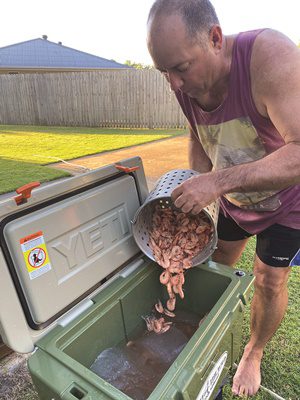


NOTHING beats the sound and feel of prawns flicking in the cast net.
Update yourself on the Fisheries Queensland legal limits as a boat limit of 20 litres of prawns now applies if two or more people are on board, in addition to individual limits of 10 litres per person. Prawns have been schooling in the deep holes in the estuary systems of the Great Sandy Strait. We have found prawning two hours either side of low tide produces the best numbers.prawning great sandy strait
You can locate patches of prawns on your sounder and you’ll find they look like clumped speckles. It’s also possible to spot prawns in the Sandy Strait shallows when motoring around in depths of 1-1.5m. They will often skip across the surface to escape the boat and engine noise.
The schools will move around, so you will need to go looking to locate them. Three main styles of cast net are on the market: top-pocket, drawstring and standard. We like to use a 12’ top-pocket cast net to catch prawns in the Sandy Strait. The larger the drop, the larger the circle.
In deeper water, prawns will flick to the top of the net trying to escape and get caught in the top pocket, but often you will have a few left in the bottom pocket as well. A top-pocket net makes it easier to clear the net of prawns. The majority of prawns will skip and tunnel up into the top pocket, so a quick release of the drawstring to clear the prawns out of the net and you will be ready for your next cast.
A 1” mesh net is preferable because it allows the small prawns to escape and you only catch the better quality. A drawstring net is effective in both shallow and deep water. The net closes on itself and draws up and traps the prawns. An easy release of the centre cord and the net is opened and prawns released.
A standard net only has a bottom pocket. The bottom pocket is effective in shallow water.prawning great sandy strait
It is recommended to use a net size you feel comfortable throwing. You should pick your days wisely because the wind can make it harder to throw your net. Throwing a full circle over a school, no matter what size drop, will catch more prawns.prawning great sandy strait
Everyone has a preferred style of net and method of throwing. Mesh size and drop is determined by the preference of individuals.
To cook a batch of green school prawns, use 10 litres of sea water in your crab cooking pot, a cup of salt and bring to the boil, then boil for two minutes. Add them to a slurry of icy cold sea water and add an extra cup of salt. This will set the prawns as they cool.prawning great sandy strait
Taste them after 15 minutes and add more salt if required. If we get more rain over coming weeks and the creeks run fresh again, it is possible the prawns will move out closer to the mouths of estuaries.
Try my tempura prawn recipe out, which you can find by clicking this link. It is simple, tastes yummy and you can make it your own with your favourite dipping sauce.prawning great sandy strait
 Bush 'n Beach Fishing Magazine Location reports & tips for fishing, boating, camping, kayaking, 4WDing in Queensland and Northern NSW
Bush 'n Beach Fishing Magazine Location reports & tips for fishing, boating, camping, kayaking, 4WDing in Queensland and Northern NSW








